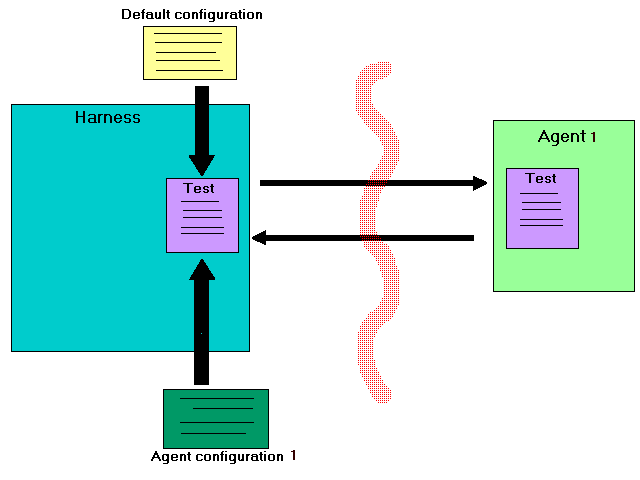
To completely
validate the product, we need to run our test suite on the following
architectures :
Solaris (Intel)
Solaris (Sparc)
Windows NT (Intel)
Windows NT (Alpha)
Windows 95
Now since our
product is communicating between two machines, we need to confirm it
interoperates between any combination of the above architectures.
So we have the following combinations :
| Solaris Intel | Solaris Sparc | Windows NT Intel | Windows NT Alpha | Windows 95 | |
| Solaris Intel | X | X | X | X | X |
| Solaris Sparc | X | X | X | X | X |
| Windows NT Intel | X | X | X | X | X |
| Windows NT Alpha | X | X | X | X | X |
| Windows 95 | X | X | X | X | X |
To further
complicate our lives, we assume XFtp is written in Java, so we need to
test it on Java 2 and Java 1.1.8. This nicely increases our test
combinations from 25 to 50.
It soon becomes clear that as new variables are added, the number of
test combinations spirals rapidly out of control. It gets MUCH worse
when you are testing real distributed software running on multiple
machines. We currently run our tests on 16 different machines! (If we
limit ourselves to Solaris Intel and Solaris Sparc, this still gives 20
922 789 888 000 combinations!) Clearly some automation of this process
would be a good idea.
This is still only
half the problem. Each machine has to be installed with the software to
be tested. With the engineering department sometimes delivering new
versions 2 or three times a week, this also gets to be a very time
consuming process.
Step one is to write your each test case in a platform independant way. To do this, we developed a simple scripting language, very similar to C-shell, although it could be implemented as any language you want. All references to platform specific items are delayed by referring to one or more configuration files. A configuration is then built up for each test based on the architecture and operating system of the target machine.
So instead of directly executing a command within the test, we refer to variables which will only be defined at the time of running the test. For example, to start a Java Virtual Machine, instead of using :
execute("c:\jdk1.2\bin\java.exe TestCaseClass")
we would use :
JAVA_CMD=JAVA_CMD_AGENTNAME
execute(JAVA_CMD+"TestCaseClass")
In this way, we don't care at the test level what type of machine the test will run on. Somewhere higher up in the configuration hierarchy we might have a file which defines these values as :
IF (AGENT1_OS=="WindowsNT")
JAVA_CMD_AGENTNAME="c:\jdk1.2\bin\java.exe"
ELSE
JAVA_CMD_AGENTNAME="/usr/bin/java"
The second, and
possible more important step, is to transfer the test to whatever
machine we want to run it on (agent).
This was achieved by developing a relatively stupid agent that can
respond to a limited set of requests from the harness via TCP sockets.
Some examples are GETFILE, SENDFILE, DELFILE, EXECUTE etc. The test
script running on the harness may then use this command set to build up
a desired environment on the agent. We are able to transfer files,
unzip files, delete files, set environment variables, and any of the
other good things we need to run a test. Once the test is run, a result
is decided on, and sent back to the harness for processing.
Since the agent is written in Java, it runs on any architecture
supporting a JVM, included restricted ones running pJava, kJava nad
various other slimmed down versions.
The data flow
outline is presented in Figure 1 :

Enter the QAT Tool.
It is a test harness which centralises all the tests onto the platform
of your choice(it's 100% Pure Java), and all you need to do is run a
simple agent on your test machine, which listens on a TCP socket for
commands from the Harness.
Tests are written in the form of a specially designed scripting
language, but this may be redefined as per user needs by overriding the
parser interface.
The tests have available to them, a limited, but powerfull set of
commands which may be run on an agent machine, such as sending and
recieveing files, starting, stopping and killing processes etc. All
output of the test running on the agent is stored, and sent back to the
harness if requested.
So all tests, associated files, and other bits and pieces used to run
the suite are stored locally on a single machine, and are sent to the
agent machine as required.
All that is required to run ANY test suite on ANY machine, is a Java
Virtual Machine running the QAT Agent. It is also possible to get the
agent to update itself when new software is available, meaning once a
machine is running the agent, it need never be reconfigured.